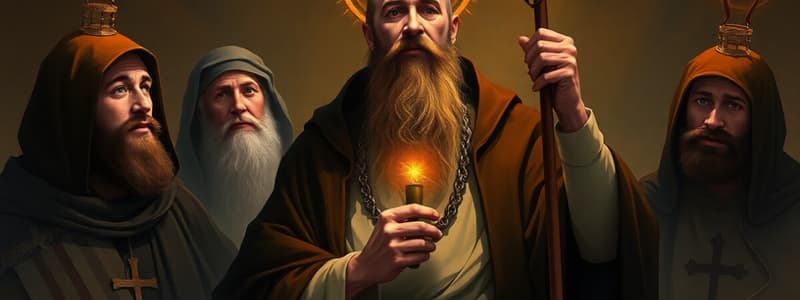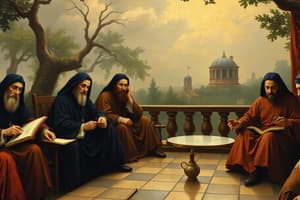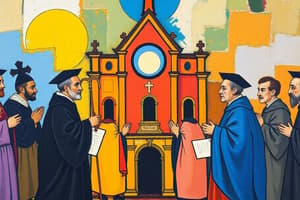Podcast
Questions and Answers
What was the primary goal of the Catholic Reformation?
What was the primary goal of the Catholic Reformation?
- To establish new colonies in the Americas
- To promote Protestant teachings within the Catholic Church
- To address internal corruption and counter the Protestant Reformation (correct)
- To modernize church architecture and art
The Catholic Reformation occurred before the Protestant Reformation.
The Catholic Reformation occurred before the Protestant Reformation.
False (B)
Name one specific issue within the Catholic Church that was identified by the cardinals appointed by Pope Paul III.
Name one specific issue within the Catholic Church that was identified by the cardinals appointed by Pope Paul III.
issuing indulgences for money
The Society of Jesus, also known as the __________, was influential in promoting the Catholic Reformation.
The Society of Jesus, also known as the __________, was influential in promoting the Catholic Reformation.
Match the following figures with their roles in the Reformation:
Match the following figures with their roles in the Reformation:
Which European regions primarily remained Catholic after the initial spread of Protestantism?
Which European regions primarily remained Catholic after the initial spread of Protestantism?
One goal of the Catholic Reformation was to bring former Catholics back into the faith.
One goal of the Catholic Reformation was to bring former Catholics back into the faith.
What broad action did Pope Paul III take in 1536 to address the issues within the Catholic Church?
What broad action did Pope Paul III take in 1536 to address the issues within the Catholic Church?
What event prompted Ignatius of Loyola to pursue a religious life?
What event prompted Ignatius of Loyola to pursue a religious life?
Ignatius of Loyola immediately became a priest after leaving the military.
Ignatius of Loyola immediately became a priest after leaving the military.
What is the name of the inspirational text created from Ignatius of Loyola's journals?
What is the name of the inspirational text created from Ignatius of Loyola's journals?
Ignatius of Loyola was born in the year __________.
Ignatius of Loyola was born in the year __________.
Match the historical event with its year.
Match the historical event with its year.
What advice did Ignatius of Loyola give to his fellow Jesuits?
What advice did Ignatius of Loyola give to his fellow Jesuits?
Which country's military was Ignatius a part of before he became a priest?
Which country's military was Ignatius a part of before he became a priest?
Ignatius of Loyola was declared a saint before his death.
Ignatius of Loyola was declared a saint before his death.
What was the primary role of the Jesuits in the Catholic Reformation?
What was the primary role of the Jesuits in the Catholic Reformation?
The Council of Trent was primarily focused on creating a compromise with Protestant reformers to unify Christianity.
The Council of Trent was primarily focused on creating a compromise with Protestant reformers to unify Christianity.
Besides the Bible, what other foundation of Catholic beliefs was affirmed by the Council of Trent?
Besides the Bible, what other foundation of Catholic beliefs was affirmed by the Council of Trent?
The Council of Trent met in three separate sessions between 1545 and ______ CE.
The Council of Trent met in three separate sessions between 1545 and ______ CE.
Match the following actions with their purpose during the Catholic Reformation:
Match the following actions with their purpose during the Catholic Reformation:
Why did the Catholic Church recognize the power of the printed word during the Reformation?
Why did the Catholic Church recognize the power of the printed word during the Reformation?
Which European countries remained primarily Catholic during the Reformation?
Which European countries remained primarily Catholic during the Reformation?
What was the name of the Pope who summoned the Catholic bishops of Europe to Trento in 1545 CE?
What was the name of the Pope who summoned the Catholic bishops of Europe to Trento in 1545 CE?
What was the primary goal of the Council of Trent's decision to control what Catholics were allowed to read?
What was the primary goal of the Council of Trent's decision to control what Catholics were allowed to read?
The Index of Forbidden Books primarily targeted secular literature and had little focus on religious texts.
The Index of Forbidden Books primarily targeted secular literature and had little focus on religious texts.
Besides the Index of Forbidden Books, what other primary tool did the Catholic Church use to counteract Protestant ideas during the Reformation?
Besides the Index of Forbidden Books, what other primary tool did the Catholic Church use to counteract Protestant ideas during the Reformation?
The Council of Trent had Church leaders review new publications, and if those materials went against Church teachings, they were __________.
The Council of Trent had Church leaders review new publications, and if those materials went against Church teachings, they were __________.
Match the following actions/entities with their purpose during the Counter-Reformation:
Match the following actions/entities with their purpose during the Counter-Reformation:
Which of the following was a consequence of the Reformation and Catholic Reformation in Europe?
Which of the following was a consequence of the Reformation and Catholic Reformation in Europe?
What was one positive outcome of the Reformation and Catholic Reformation?
What was one positive outcome of the Reformation and Catholic Reformation?
The problems in the Catholic Church that triggered the Reformation were completely unresolved by the second half of the 1500s.
The problems in the Catholic Church that triggered the Reformation were completely unresolved by the second half of the 1500s.
Flashcards
Catholic Reformation (Counter-Reformation)
Catholic Reformation (Counter-Reformation)
The Catholic Church's response to the Protestant Reformation, aimed at addressing corruption, clarifying beliefs, and halting the spread of Protestantism.
Pope Paul III
Pope Paul III
The Pope who initiated the Catholic Reformation in 1536 CE by appointing cardinals to investigate issues within the Church.
Cardinals' Investigation
Cardinals' Investigation
A group of high-ranking officials appointed by Pope Paul III to identify problems and suggest reforms within the Catholic Church.
Corrupt Practices Identified
Corrupt Practices Identified
Signup and view all the flashcards
Goals of the Catholic Reformation
Goals of the Catholic Reformation
Signup and view all the flashcards
New Religious Orders
New Religious Orders
Signup and view all the flashcards
The Jesuits
The Jesuits
Signup and view all the flashcards
Ignatius of Loyola
Ignatius of Loyola
Signup and view all the flashcards
1491 CE
1491 CE
Signup and view all the flashcards
Battle of Pamplona (1521 CE)
Battle of Pamplona (1521 CE)
Signup and view all the flashcards
Spiritual Exercises
Spiritual Exercises
Signup and view all the flashcards
Serve without hard words.
Serve without hard words.
Signup and view all the flashcards
1556 CE
1556 CE
Signup and view all the flashcards
Saint Ignatius of Loyola
Saint Ignatius of Loyola
Signup and view all the flashcards
Catholic Reformation
Catholic Reformation
Signup and view all the flashcards
Jesuits
Jesuits
Signup and view all the flashcards
Jesuit Impact
Jesuit Impact
Signup and view all the flashcards
Council of Trent
Council of Trent
Signup and view all the flashcards
Council Declarations
Council Declarations
Signup and view all the flashcards
Catholic Foundations
Catholic Foundations
Signup and view all the flashcards
Council Reforms
Council Reforms
Signup and view all the flashcards
Index of Forbidden Books
Index of Forbidden Books
Signup and view all the flashcards
The Inquisition
The Inquisition
Signup and view all the flashcards
The Reformation
The Reformation
Signup and view all the flashcards
Censorship
Censorship
Signup and view all the flashcards
Heresy
Heresy
Signup and view all the flashcards
Council of Trent's Actions
Council of Trent's Actions
Signup and view all the flashcards
Positive outcomes
Positive outcomes
Signup and view all the flashcards
Study Notes
- The Catholic Church responded to the Protestant Reformation through the Catholic Reformation, also known as the Counter-Reformation
- The Catholic Reformation opposed the Protestant Reformation
- Pope Paul III initiated the Catholic Reformation
The Catholic Reformation Gets Underway
- Pope Paul III appointed a group of cardinals in 1536 CE to investigate issues within the Church
- The cardinals found corrupt practices like selling indulgences, an uneducated priesthood, and religious orders not following Church teachings
Ignatius of Loyola and the Jesuits
- Pope Paul III encouraged new religious orders to help promote reform, including the Society of Jesus, or the Jesuits
- Ignatius of Loyola, a Spanish priest, founded the Jesuits
- Ignatius was born in 1491 CE and was a soldier before becoming a priest
- Injured in battle, Ignatius spent his recovery reading religious texts, leading him to become a priest
- Ignatius kept journals about the challenges of his calling and created "Spiritual Exercises" to guide others
- Ignatius was elected the first leader of the Society of Jesus
- Ignatius died in 1556 CE and was declared a saint in the early 1600s, becoming St. Ignatius of Loyola
- The Jesuits worked to revive Catholicism in Europe and spread the faith to the New World
- Members of the Jesuit order were well-educated and dedicated to teaching, building schools and universities
- Jesuits became tutors to nobles in Europe and missionaries, spreading education and Catholic beliefs to the Americas and Asia
- The Jesuits helped the Church regain influence and grow beyond Europe
Council of Trent
- Pope Paul III summoned Catholic bishops to Trento, Italy in 1545 CE to reform the Church
- The Council of Trent was the Catholic Church's response to the Reformation
- The Council of Trent met in three sessions between 1545 and 1563 CE and issued declarations clarifying disagreements with Protestant reformers
- The Council of Trent affirmed Church traditions and the Bible as the foundation of Catholic beliefs and took steps to reform corrupt practices by issuing decrees
- Decisions of the Council revitalized and unified the Catholic Church
- Some parts of Europe that had turned to Protestantism, including Austria, Poland, and Bavaria, reverted back to Catholicism
Other Actions of the Council
- The Council of Trent aimed to control what Catholics could read to stop the spread of anti-Catholic writings
- Church leaders reviewed new publications and censored those against Church teachings
- The Council created the Index of Forbidden Books, a list of banned publications to prevent immoral writings from corrupting followers
- Books written by Protestants and some reform-minded Catholics like Desiderius Erasmus were banned
- The Inquisition was revived to root out heresy
- The Index of Forbidden Books and the Inquisition were the two primary tools that the Church used to counteract Protestant ideas
Results of the Reformations
- By the second half of the 1500s, the Council of Trent had purged the Church, leaving it stronger and more united
- Catholics and Protestants would remain divided despite some issues being resolved
- Christians in Europe were bitterly divided, with persecution of Protestants in Catholic-controlled areas and vice versa
- The reformations sparked many years of warfare in Europe
- Positive outcomes included ordinary people having access to Bibles in their native language and the ability to choose their religion
- Individuals could associate with others sharing the same beliefs
- Kings gained greater control, and subjects identified more with countries and empires than with a particular religion
Studying That Suits You
Use AI to generate personalized quizzes and flashcards to suit your learning preferences.




